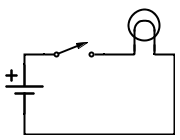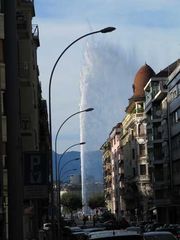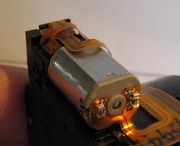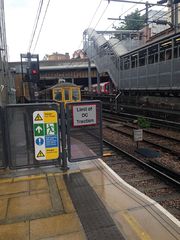Electric circuits, volts amps watts and ohms
A very basic understanding of how electricity behaves is required for electrical repairs, and vital for working on mains-powered items. Here are the essentials, explained in simple terms.
Summary
A knowledge of basic electrical theory is essential for anything more than purely mechanical repairs, and will greatly help in diagnosing faults and working safely.
Safety
- In the worst case scenario (wet hands and standing in the bath) you can kill yourself with 50V. In normal circumstances anything less will give you no more than an unpleasant tingle. Much higher voltages, for example from static build-up, can give you a nasty jolt but may be incapable of killing you if they are unable to sustain sufficient current. Nevertheless, if the jolt causes you to fall off a ladder or cause some other accident, it might kill you that way instead.
- An excessive current flowing in a wire will make it hot. Uncontrolled, it can cause serious burns or start a fire.
- Mains-powered appliances such as vacuum cleaners, washing machines and power tools contain powerful electric motors which can easily cause injury to fingers.
Electrical Circuits - doing the rounds
An atom consists of a very dense nucleus carrying a positive electric charge surrounded by a cloud of electrons, each having a negative electric charge. Normally, the positive and negative charges cancel exactly. Positive and negative charges attract one another, which is what keeps the electrons bound in an atom. Conversely, like charges repel.
In a metal, some of the electrons are not bound to any particular atom but are free to wander off. Nevertheless, the total of the positive and negative charges remain equal in the lump of metal as a whole. If these electrons move in a steady stream in one direction, e.g. along a piece of wire, we have an electric current.
Since electrons all have a negative charge they repel each other and hence they really hate piling up. So unless they can all move together around a complete circuit and back to where they started, they immediately back up at any obstruction all the way back round the circuit to the other side of the blockage.
The figure shows a very simple circuit consisting of a battery, a switch and a torch bulb. The switch is shown open and so no electricity can pass through it, so none flows anywhere in the circuit. If you close the switch and so complete the circuit, an electric current can flow from one side of the battery, through the switch and the bulb, and back to the other side of the battery.
Electrons carry a negative charge and so are repelled by the negative terminal of the battery and attracted around the circuit to towards the positive terminal. However, in explaining a circuit we often talk about the electricity flowing from positive to negative. Indeed, sometimes an electric current does consist of positively charged atoms moving from positive to negative. Positive to negative or negative to positive, it makes no difference. Whichever best helps you to understand a circuit is the one to use.
Volts - the pressure is on
Voltage is like the electrical pressure. If you put your thumb over the bathroom tap and turn it on, you can probably stop the flow because you're only holding back the pressure of the water from the tank in the loft just a few feet above your head. If you try the same at the kitchen tap, probably fed directly off the water main, you're likely to get very wet because the pressure is much higher. The Jet d'Eau at Geneva uses an enormous pressure to create a fountain several hundred feet high. Imagine trying to stop that with your thumb!
In the circuit we looked at above the current is driven round the circuit by a battery. That might be an AA cell, which doesn't push very hard. We measure the pressure in volts, of which an AA cell will give us around 1.5, and so it will be labelled 1.5V. If you replaced the battery in our circuit by a source of a few thousand volts, the pressure would be so great that the electricity would form a spark in order to jump over the open switch. And the bulb probably wouldn't last long either!
It takes roughly 3,000V (3kV) to create a 1mm spark. So a kilometre long lightning flash implies a voltage of 3 billion volts!
Mains electricity comes at 240v, which is enough to do useful work but not so much as to jump across a switch or break out anywhere else it's not meant to go.
Amps - go with the flow
As well as the pressure (voltage), we'll also be interested in how heavy the flow of electricity is, i.e. just how many electrons pass a given point per second. This is the current, measured in Amps, milliamps (mA - thousandths of an amp) or microamps (μA - millionths of an amp). Remember, since electrons don't like piling up, the current has got to be the same at every point around a simple circuit.
Again, we can use the analogy of water. A dripping tap represents a very small flow of water - it might take hours to fill a litre jar. On the other hand, some 2,400 cubic metres of water per second flow over Niagara Falls on average. A small solar cell like the ones on solar garden lights can only produce perhaps a few tens of milliamps of current, but a car battery might deliver 100 amps (written 100A) to turn the starter motor.
Just as you need a fat pipe to supply water to a whole town, so you need fat wires to carry a heavy current. The wires connected to a car battery are much thicker than most other wires you're familiar with.
Watts - feel the power
If you need a lot of power, for instance to drive a train, you can get it either by increasing the voltage (pressure), or the current (flow). Or both.
Doubling the voltage but keeping the same current doubles the power, and so does doubling the current at the same voltage. So if we multiply the volts by the amps we get the power in watts (W):
Watts = Volts x Amps
We also use kilowatts (KW - thousands of watts) and megawatts (MW - millions of watts).
Trains running through London on the Thameslink line take their power on the northern section from overhead lines at 25,000V installed in the 1980's. But on the South they use an older third rail system delivering the same power at 750V. The higher voltage means much less current is needed, and so much thinner wires can be used. A high voltage couldn't be used on a third rail as it's only a few inches from the running rails and the ground, and would be extremely dangerous for track maintenance workers or for anyone falling or trespassing onto the track. However, the third rail has a large cross sectional area and so can carry a heavy current.
Mains electricity is delivered at 240V. A plug fitted with a 3A fuse is therefore suitable for appliances up to 240 x 3 = 720W. A 13A fuse is good for up to 240 x 13 = 3120W.
Turning the formula around, you can divide the watts by the volts to get the amps. A 1000W appliance therefore takes 1000 / 240 = 4.167A, so a 5A fuse should suffice.
Mechanical power is often measured in horsepower (HP), but mechanical and electrical power can be converted either into the other at the rate of 1HP = 746W. If someone complained to you that their tea wasn't strong enough you could retort that it was made with a 4HP kettle - which would be perfectly true for a 3kW kettle!
Ohms - resistance isn't futile
You apply a certain voltage to a circuit. So what determines how much current flows, and hence how much power you get? That's where resistance comes in!
Going back to the water analogy, if you had a long thin hosepipe you'd need quite a lot of pressure get a good flow, but you could push a lot more water through a short fat pipe with the same pressure. It's all down to the resistance the pipe offers to the flow of water.
Any piece of wire has a certain resistance, though not much unless it's very thin or very long (or both). The resistance causes energy loss, which turns up as heat. The element in an electric heater or a kettle is deliberately made with enough resistance to generate the heat you want.
Resistance is measured in ohms. It's the number of volts you'd need to drive one amp round the circuit. In other words, it's the volts per amp. So:
Ohms = Volts / Amps
If you divide the voltage by the current for an electric motor when it's running you'll get a much higher value than what you'd measure with a test meter. This apparent resistance is what is soaking up the energy and turning it into mechanical energy. It arises because any motor also acts as a dynamo, generating a voltage which opposes the applied voltage. The test meter is only measuring the resistance of the copper wire inside the motor. Equally, an LED or a transmitting aerial exhibits resistance, representing the electrical power converted into light or radio waves.
Most metals conduct electricity well and so have a low resistance, though nothing has zero resistance at room temperature. Carbon (as graphite or charcoal) also conducts. Plastics, wood, glass, ceramics etc are generally insulators, which means they have a very high resistance and hardly conduct electricity, if at all.
A "short circuit" is when a connection is accidentally made which bypasses the parts of a circuit containing the resistance which would normally limit the current. With little resistance, a very heavy and damaging current can flow. This is likely to cause excessive heating in whatever resistance remains, such as the wires leading to or causing the short circuit.
As an aside, silicon is called a semiconductor because, although when very pure it's nearly an insulator, you can make it conduct by selectively introducing specific impurities. But according to whether the impurity has one more or one less electron than silicon in the outermost layer of its atoms, the current is carried either by negative charges (the extra electrons), or effectively by positive charges moving in the opposite direction (the "holes" left by the lack of an electron, which can move like bubbles). By using both types of impurity in different parts of a silicon chip you can do some very cunning things!









